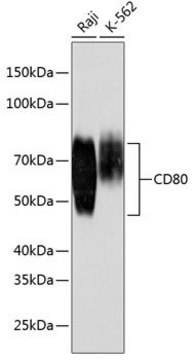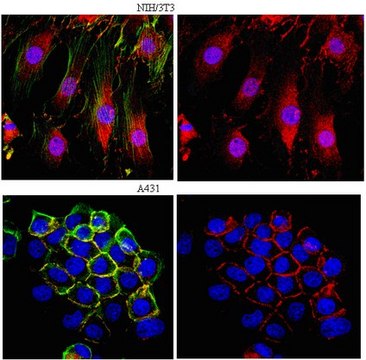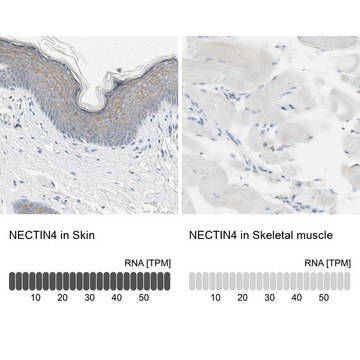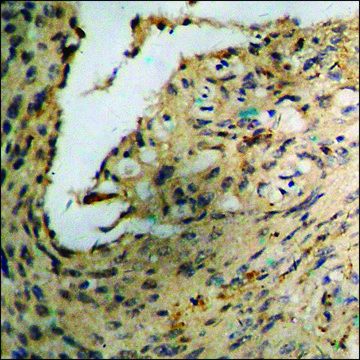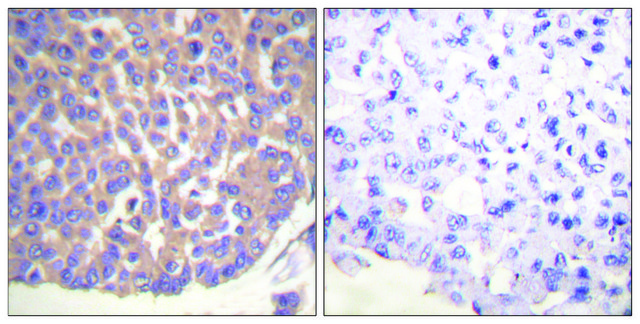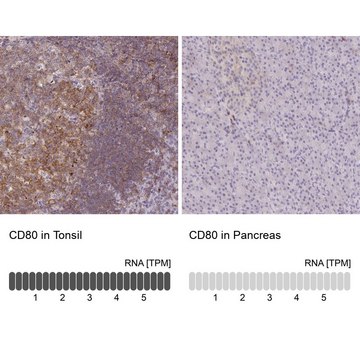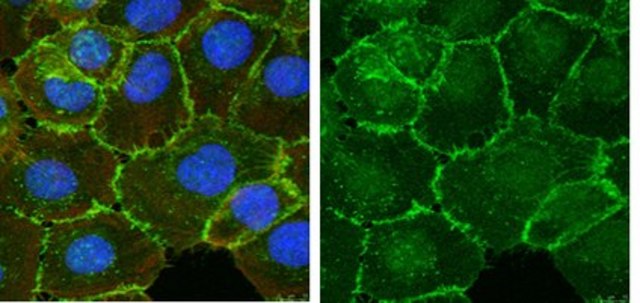SAB4500696
Anti-EFNA1 antibody produced in rabbit
affinity isolated antibody
Sign Into View Organizational & Contract Pricing
All Photos(2)
Synonym(s):
B61, ECKLG, EFL1, EPH-related receptor tyrosine kinase ligand 1, ephrin-A1
Recommended Products
biological source
rabbit
Quality Level
conjugate
unconjugated
antibody form
affinity isolated antibody
antibody product type
primary antibodies
clone
polyclonal
form
buffered aqueous solution
mol wt
antigen 23 kDa
species reactivity
human, mouse, rat
concentration
~1 mg/mL
technique(s)
ELISA: 1:10000
immunofluorescence: 1:100-1:500
western blot: 1:500-1:1000
NCBI accession no.
UniProt accession no.
shipped in
wet ice
storage temp.
−20°C
target post-translational modification
unmodified
Gene Information
human ... EFNA1(1942)
General description
EphrinA1 (EFNA1), also known as angiogenesis factor, is encoded by the gene mapped to human chromosome 1q21-22. The encoded protein belongs to subclass A of ephrin family. EFNA1 is localized to cell membrane via a glycosylphosphatidylinositol (GPI) moiety. EFNA1 ligand preferentially binds to the receptor tyrosine kinase, Eph receptor 2 (EphA2).
Immunogen
The antiserum was produced against synthesized peptide derived from human EFNA1.
Immunogen Range: 66-115
Immunogen Range: 66-115
Application
Anti-EFNA1 antibody produced in rabbit has been used in western blot analysis.
Biochem/physiol Actions
EphrinA1 (EFNA1) and its primary receptor, Eph receptor 2 (EphA2) are associated with various cancers, such as urinary bladder carcinoma, breast cancer gastric cancer, glioma and malignant mesothelioma. Expression pattern of EFNA1 can be used as a potential prognostic marker in colorectal cancer (CRC) patients and other human malignancies. Experimental studies state that, EphrinA1 (EFNA1) can be involved in both tumor promotion and inhibition, based on whether ephrin-A1 is bound to the receptor in soluble or membrane bound form, respectively. Activation of EphA2, induces indirect growth signal by overcoming ‘contact inhibition′.
Features and Benefits
Evaluate our antibodies with complete peace of mind. If the antibody does not perform in your application, we will issue a full credit or replacement antibody. Learn more.
Physical form
Rabbit IgG in phosphate buffered saline (without Mg2+ and Ca2+), pH 7.4, 150mM NaCl, 0.02% sodium azide and 50% glycerol.
Disclaimer
Unless otherwise stated in our catalog or other company documentation accompanying the product(s), our products are intended for research use only and are not to be used for any other purpose, which includes but is not limited to, unauthorized commercial uses, in vitro diagnostic uses, ex vivo or in vivo therapeutic uses or any type of consumption or application to humans or animals.
WGK
nwg
Flash Point(F)
Not applicable
Flash Point(C)
Not applicable
Regulatory Information
常规特殊物品
Certificates of Analysis (COA)
Search for Certificates of Analysis (COA) by entering the products Lot/Batch Number. Lot and Batch Numbers can be found on a product’s label following the words ‘Lot’ or ‘Batch’.
Already Own This Product?
Find documentation for the products that you have recently purchased in the Document Library.
The genes encoding the eph-related receptor tyrosine kinase ligands LERK-1 (EPLG1, Epl1), LERK-3 (EPLG3, Epl3), and LERK-4 (EPLG4, Epl4) are clustered on human chromosome 1 and mouse chromosome 3.
Cerretti DP, et al.
Genomics, 33(2), 277-282 (1996)
Lyka Potla et al.
Cancer letters, 175(2), 187-195 (2001-12-14)
Ephrin A1 (EFNA1) is a GPI-anchored ligand that preferentially binds to the receptor tyrosine kinase, EphA2. EphA2 is over-expressed in malignant melanocytes and in prostate carcinoma cells. Whether activation of EphA2 by EFNA1 is involved in aberrant growth or differentiation
T Tawadros et al.
British journal of cancer, 107(10), 1737-1744 (2012-10-06)
High intake of omega-6 polyunsaturated fatty acids (PUFA) has been associated with clinical progression in prostate cancer (CaP). This study investigates the signalling mechanism by which the omega-6 PUFA arachidonic acid (AA) induces prostatic cellular migration to bone marrow stroma.
Hirofumi Yamamoto et al.
International journal of oncology, 42(2), 549-555 (2012-12-22)
We previously studied hypoxic tumor cells from hepatic metastases of colorectal cancer (CRC) and determined several potential prognostic factors, including expression
Sho Kohara et al.
Biomedicines, 10(12) (2022-12-24)
Kupffer cells are maintained via self-renewal in specific microenvironmental niches, primarily the liver sinusoidal endothelial cells (LSECs). In this study, we propagated tissue-resident macrophages (Mø) from mouse liver using mixed culture with hepatic fibroblastic cells. Propagated liver Mø express Id3
Our team of scientists has experience in all areas of research including Life Science, Material Science, Chemical Synthesis, Chromatography, Analytical and many others.
Contact Technical Service
